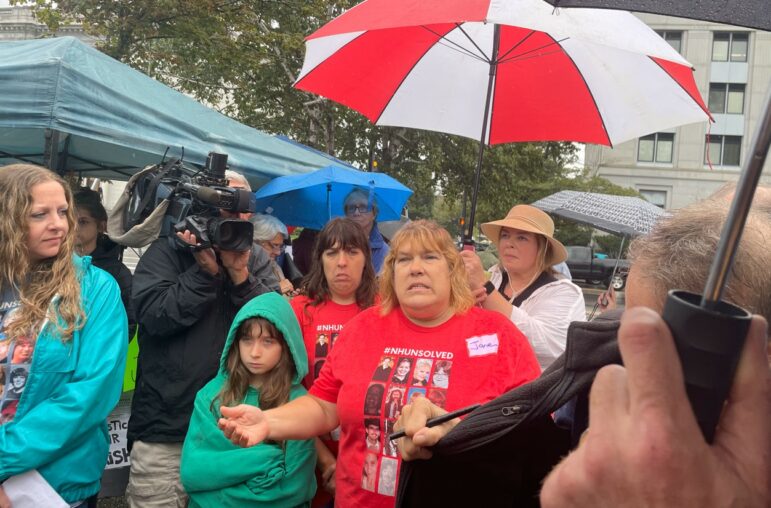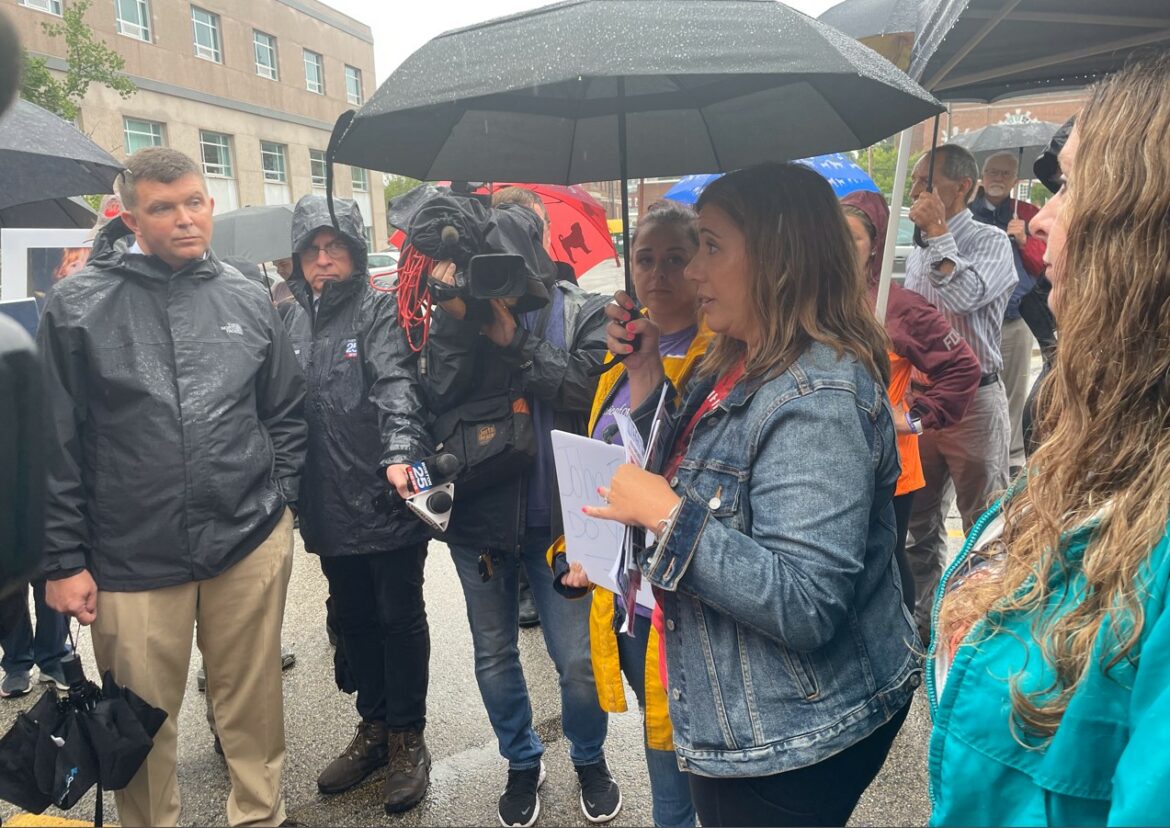
Above, Jane Boroski, who recovered after being stabbed 27 times in Swanzey Aug. 6, 1988, on her way home from the Cheshire County Fair, is described as the lone survivor of the unsolved Connecticut River Valley Killer. She was seven months pregnant at the time. She is pictured Tuesday at the rally at the Attorney General’s Office. Paula Tracy photo
By PAULA TRACY, InDepthNH.org
CONCORD – Families of some of the roughly 130 unsolved murders and missing persons cases in New Hampshire gathered outside the Attorney General’s Office Tuesday to collectively ask for better communication and more help in solving the cases involving their loved ones.
Family and friends of Trish Haynes, Maura Murray, Lorne Boulet, and Jason Upton were among the more than 50 people who stood in the rain before the Department of Justice holding signs including one asking Attorney General John Formella to “do your job.”
Formella did not attend the event, but officials from his office attended, saying that they were not there to make it about them but to let the victims have their say.
They offered up meetings on individual cases.
The group has recently banded together and said they have had similar experiences with a lack of regular contact with the state agency which prosecutes homicides and the State Police which in most cases is responsible for investigations within the Department of Safety.
“People say if you want to get away with murder, go to New Hampshire,” said Valorie Haynes Alverez as she confronted Michael Garrity, director of communications for the Department of Justice.
She is the great aunt of Trish Haynes, 26, whose body was found in Grafton following her disappearance in 2018.
The group had several goals for the gathering. In a press release issued before the event the coalition had four major goals for the event: to raise awareness of cases, including some which have had little media attention; reform of the state’s victim advocacy program; improved communication and securing justice for the victims.
They said as they provide tips to police it is a one way street with silence on whether or not that information led somewhere.
Megan Charlesworth said she was there to bring awareness to the cold case involving her friend Heidi Martin, 16, who died in Hartland, Vt. in 1984. Her body was found the next day in a brook behind the Hartland Elementary School.
It remains an unsolved case though some believe it is possible it is linked to other murders in the Upper Valley of New Hampshire.
Jane Boroski, who is described as the lone survivor of the unsolved Connecticut River Valley Killer attended.
Kelly Holden came from Tennessee for the event to press for justice for her “little brother, Jason Upton” of Allenstown who was found in the Merrimack River in 2009.
“I call Allenstown every single year trying to find what is going on,” she said. “We don’t have any new evidence,” she said.
“I think it is a lack of resources,” she said also and job turnover in law enforcement and at the Attorney General’s Office.
“We need to push it, we need to have more investigation,” she said.
Also she said a contributing factor to the lack of justice is a backlog of cases, and she alleged those who do not have “high society” family and friends get relegated to a different pile.
She said her mother, Diane Vattes, could not attend the event and has never been the same since the loss of her “baby,” who died at age 34.
Maura Murray has been missing for 19 years after she disappeared February 9, 2004 at age 21 after her vehicle crashed along the Wild Ammonoosuc Road in Haverhill.
Her older sister, Julie Murray attended the gathering and spoke to investigators and said that no person attending should have to be at the event seeking justice.
A list of the victims and their cold cases in New Hampshire is available here https://www.doj.nh.gov/criminal/cold-case/victim-list/index.htm
To join the new coalition and get more information, go to NHunsolved@gmail.com
In a news release, Mike Garrity said: “We at the New Hampshire Department of Justice never forget that at the heart of each of our homicide cases are real people with families who love and miss them. We support Tuesday’s gathering as something positive – victims and their families coming together, using their voices, and bringing awareness to their cases. Our hope is that highlighting these cases will result in more people coming forward with information that can help investigators. We are all aligned in pursuing justice for these victims and solving these cases.”
Garrity said his office is respectfully listening, continuing to actively engage privately, and offering our assurance that attention is truly being given to these cases. “The Attorney General remains ready and willing to have one-on-one or small group conversations with impacted loved ones,” Garrity said.
He said last year investigators and prosecutors were able to solve 92.3% of the state’s 2022 homicides. In contrast, the national 2022 homicide clearance rate was 54.3%. New Hampshire’s 10-year average homicide clearance rate is 88.9%, compared to 59.9% nationally, Garrity said.
He mentioned several cold cases since 2022 that have been solved, including the murder of Laura Kempton in September of 1981 in Portsmouth. Earlier this year, the Unit announced the identification after 40 years of the remains of Katherine Ann Alston, who went missing from Boston and was found murdered in Bedford, New Hampshire, on Oct. 6, 1971.
“In 2022 the Unit tried and convicted Richard Ellison for the second-degree murder of Robert McMillian in Concord on December 9, 2005. Also in 2022, the Unit solved and closed the 1972 Murder of Arlene Clevesy in Newton, NH; and it worked with Boston, MA Police to solve the 1984 murder of Brian Watson in Manchester, ultimately indicting 61-year-old Michael Lewis on a first-degree murder charge. And finally, on March 28, 2022, the Unit announced an investigation into the reported disappearance of Janis Taylor from Concord, New Hampshire, on January 8, 1968,” Garrity said.






